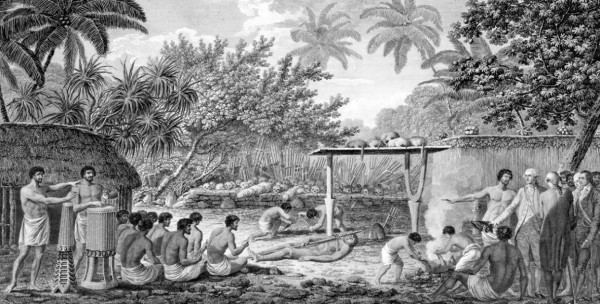By Ana Verayo, | April 05, 2016

Human sacrifice in Tahiti, Oceania during the 1700s.
A new study suggests that violent ritual killings and brutal human sacrifices such as decapitation are the very foundations of the structure of modern human societies.
Like Us on Facebook
According to co-author of the study, Joseph Watts from the University of Auckland, just 12,000 years ago, humans basically lived within egalitarian groups composed of hunter gatherers. In this new study, early stages of human sacrifice could have possibly built and sustained the existence of social class systems.
Watts believes that human sacrifice or the deliberate killing of another member of the community in a ritualistic manner to appease a divine or higher power, instilled the beginnings of social classes in a community.
This was used as punishment for taboo violations and to demoralize the underclasses, marking class boundaries and ultimately establish fear of the elites. In deeper context, it removes the blame from those who are responsible, of retaliation rooted from eliminating a sacrificial victim, to shift the blame to supernatural gods or beings.
To arrive at this conclusion, the international team analyzed and investigated 93 cultures from Madagascar, Rapa Nui to New Zealand. Their social structures vary from smaller egalitarian groups to kin based societies to complex chiefdoms, with habitats and environments ranging from atolls to larger islands.
Researchers recorded the presence and absence of human sacrifice in these different societies along with their levels of social stratification. The team then developed models to determine if human sacrifice evolved together with the emergence of social hierarchies.
Their results revealed that human sacrifice was found in 40 out of 93 cultures or 43 percent in total. Human sacrifice commonly occurred in the event of breaking a custom or a taboo, or the consecration of a newly built house or boat or even marking the death of a chieftain.
Watts and his team revealed that the human sacrifice victims are usually those of low social status such as slaves where the instigators are usually of high social status like priests and chiefs. The methods of sacrifice are also very different compared to Aztecs or Mayans with temples.
The methods of sacrifice include drowning, burning, strangulations, burial, killing someone with a club or sharp object, cutting body parts into pieces, being crushed under a canoe, pushed from a roof of a house and decapitation.
These findings reveal how religious rituals can play a darker role in the evolution of modern, complex societies where these rituals are driven by elites to make it appear as something sanctioned by a divine, higher power, but in reality, as a means for more social control.
Watts concludes that despite its gruesome nature, the results are suggesting the ritual killing helped transition from small egalitarian groups to larger stratified societies that we live in today.
This new study is published in the journal, Nature.
-
Use of Coronavirus Pandemic Drones Raises Privacy Concerns: Drones Spread Fear, Local Officials Say

-
Coronavirus Hampers The Delivery Of Lockheed Martin F-35 Stealth Fighters For 2020

-
Instagram Speeds Up Plans to Add Account Memorialization Feature Due to COVID-19 Deaths

-
NASA: Perseverance Plans to Bring 'Mars Rock' to Earth in 2031

-
600 Dead And 3,000 In The Hospital as Iranians Believed Drinking High-Concentrations of Alcohol Can Cure The Coronavirus

-
600 Dead And 3,000 In The Hospital as Iranians Believed Drinking High-Concentrations of Alcohol Can Cure The Coronavirus

-
COVID-19: Doctors, Nurses Use Virtual Reality to Learn New Skills in Treating Coronavirus Patients







